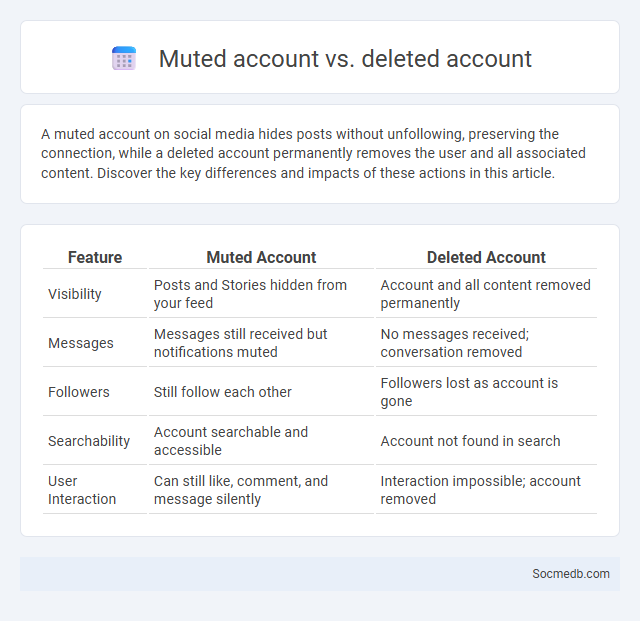
Photo illustration: Muted Account vs Deleted Account
A muted account on social media hides posts without unfollowing, preserving the connection, while a deleted account permanently removes the user and all associated content. Discover the key differences and impacts of these actions in this article.
Table of Comparison
| Feature | Muted Account | Deleted Account |
|---|---|---|
| Visibility | Posts and Stories hidden from your feed | Account and all content removed permanently |
| Messages | Messages still received but notifications muted | No messages received; conversation removed |
| Followers | Still follow each other | Followers lost as account is gone |
| Searchability | Account searchable and accessible | Account not found in search |
| User Interaction | Can still like, comment, and message silently | Interaction impossible; account removed |
Introduction: Understanding Social Media Account Statuses
Social media account statuses indicate the current state or activity level of your profile, such as active, suspended, or deactivated. These statuses affect your visibility, accessibility, and interactions on platforms like Facebook, Instagram, or Twitter. Understanding your account status helps you manage your online presence and troubleshoot any issues effectively.
What is a Muted Account?
A muted account on social media is a feature that allows users to hide posts and updates from specific accounts without unfollowing or blocking them. This tool enables users to control their feed and reduce unwanted content while maintaining a connection with the muted account. Popular platforms like Twitter, Instagram, and Facebook offer mute options to enhance user experience and minimize social media noise.
Features and Implications of Muting
Muting on social media allows users to temporarily or permanently hide posts and stories from specific accounts without unfollowing them, maintaining connection while controlling content visibility. This feature enhances user experience by reducing exposure to unwanted or triggering content, promoting mental well-being and personalized feed curation. Social media platforms leverage muting to balance user engagement and content moderation, minimizing conflict while preserving social graph integrity.
What is a Deleted Account?
A deleted account on social media refers to a user profile that has been permanently removed from the platform by the account owner or the service provider, resulting in the loss of all associated data, posts, and interactions. Unlike deactivated accounts, deleted accounts cannot be recovered, and all personal information, content, and connections are erased from the platform's database. This process ensures that the user's digital footprint is completely removed, preventing any future access or visibility on the social network.
Consequences of Deleting an Account
Deleting a social media account results in permanent loss of all shared content, including photos, messages, and contacts, which cannot be recovered later. This action can disrupt online networking opportunities and diminish digital presence, affecting personal and professional connections. Furthermore, account deletion might limit access to services that use social media credentials for login or verification purposes.
Muted Account vs Deleted Account: Key Differences
Muted accounts allow you to stop seeing posts or stories from specific users without unfollowing or blocking them, preserving your connections while maintaining your feed's relevance. Deleted accounts are permanently removed, erasing all content and interactions, and cannot be recovered, resulting in a complete loss of access to that user's updates and messages. Your choice between muting and deleting impacts how you control visibility and engagement on social media platforms.
Privacy and Visibility: What Changes?
Privacy settings on social media platforms have become more customizable, allowing You to control who can see Your posts, personal information, and activity. Enhanced encryption and stricter data policies help protect Your information from unauthorized access and data breaches. Visibility options now include detailed audience segmentation, enabling selective sharing with friends, groups, or the public.
User Experience: Interaction and Communication
Social media platforms enhance your user experience by streamlining interaction and communication through intuitive interfaces and real-time messaging features. Advanced algorithms personalize content feeds, fostering meaningful connections and active engagement. Seamless integration of multimedia tools enables expressive communication, enriching your online social interactions.
Restoring and Reversing Account Changes
Restoring and reversing account changes on social media platforms often involves verifying identity through official support channels to regain control and ensure security. Platforms like Facebook, Instagram, and Twitter offer dedicated tools for account recovery, including two-factor authentication resets and appeal processes for unauthorized changes. Prompt action and following platform-specific guidelines are critical for successfully restoring account settings and preventing future breaches.
Conclusion: Choosing Between Muting and Deleting
Choosing between muting and deleting on social media depends on how you want to manage your interactions and maintain your digital environment. Muting allows you to avoid content without severing connections, preserving relationships while reducing exposure to unwanted posts. Your decision should prioritize personal boundaries and online well-being, ensuring a positive and controlled social media experience.
 socmedb.com
socmedb.com